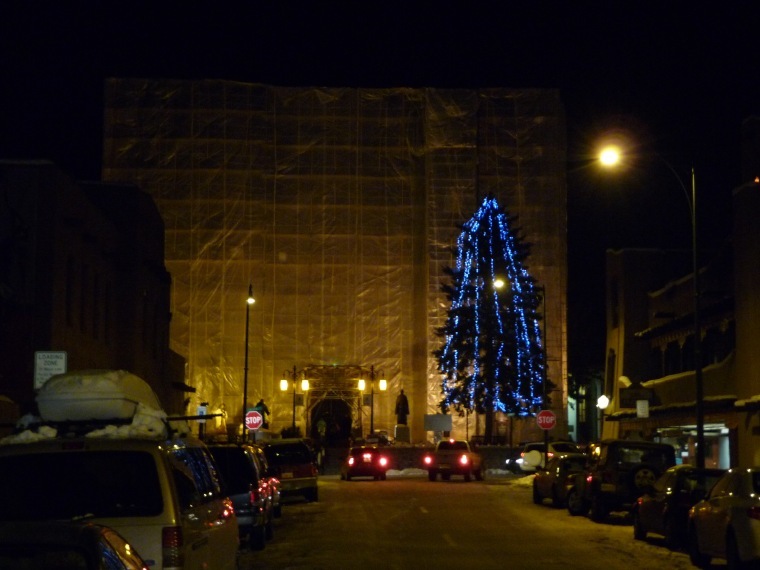
Last Christmas on San Francisco Street. photos by George Johnson
Dialing for Data
A couple of months ago, as an early Christmas present to myself, I bought a copy of Mathematica, the powerful software package invented by Steven Wolfram, a physicist/entrepreneur I’ve written about in the Times and interviewed on bloggingheads.tv. Once I’d downloaded the program, I wasn’t quite sure what to do with it, so I started playing around. I typed an arbitrary trigonometric formula — Tan[x]/Tan [y], {x, -5, 5}, {y, -5, 5} — into a Mathematica notebook page and asked for a three-dimensional plot. It looked like a good place to go hiking: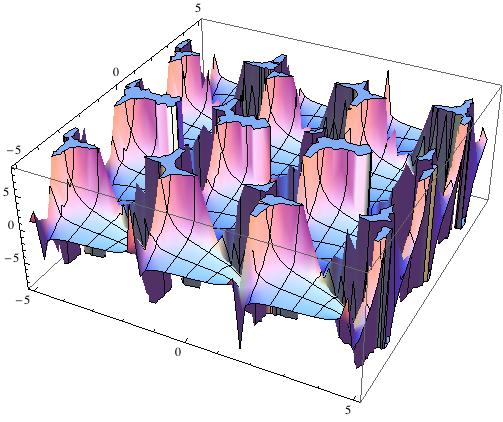
In Mathematica (but not here) the image becomes a virtual object that you can grab by the corner and twirl around, exploring every nook and cranny. Plot3D[Sec[4 x]/y^3, {x, 1, 6}, {y, 1, 6}]] gives you this:
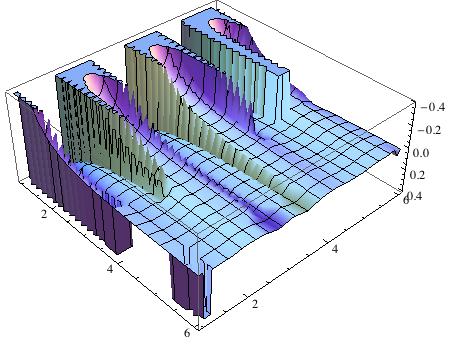
I wondered if I could find some combination of tangents, sines, and secants that would reproduce the contours of Talaya, Atalaya, and the other mountains I see from my eastern window. But I was already in over my head.
Not only can you see a function. You can hear it. In Wolframese, Plot[Sin[700 t + 100 t Sin[350 t]], {t, 0, 4}] means this:
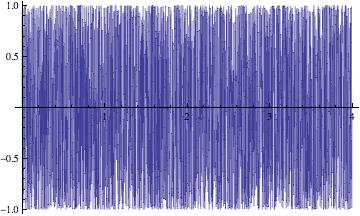
Replace “Plot” with “Play” and the image becomes a sound (Warning: Turn down the volume on your headset before pressing the button below.):
More germane to the purposes of The Santa Fe Review are Mathematica’s meteorological functions. Type in WeatherData[“KSAF”, “TotalPrecipitation”, {{1970, 1, 1}, {2009, 12, 31}, “Month”}] and Mathematica pulls in National Weather Service records of monthly precipitation at the Santa Fe Airport. I’d been looking for something like that for years. The Western Regional Climate Center has a page of historical measurements beginning in 1972. But midway through 2006 the updates inexplicably stopped. By importing the Mathematica data into a spreadsheet, I hoped to make a fuller range of information available.

Water molecule
I immediately ran into a problem, not with Mathematica but with the numbers it was getting from the weather service. According to its data, Santa Fe received 40 inches of rainfall in 1988 — and 45 inches in 1991 and 52.57 inches in 1994! This in a city where a good year might bring 12. (Maybe a corrupt database explains the suspiciously high normal rainfall figures in the New Mexican’s daily weather chart.) On the other hand, we’re informed, it didn’t rain a drop in Santa Fe from October 1981 until September 1984, a three-year drought that somehow hasn’t made it into the history books.
In search of better information, I reluctantly turned to the confusing labyrinth of a website run by the National Oceanic and Atmospheric Administration. Many clicks later I finally found historical records from 1932 through 2009. But there was a catch. This is government information paid for by taxes. By all rights it should be in the public domain. But NOAA wanted $100 for access. Through some weird fluke, I found that if I started with 1933 instead of 1932 the price fell to $40. So I put the item in my shopping cart and paid with a credit card.
Here’s what I got for the money, an unruly data dump that began like this:
COOPID,WBNID,STATION NAME ,CD,ELEM,UN,YEAR,A,S,MO,DA, JAN ,F,F,MO,DA, FEB ,F,F,MO,DA, MAR ,F,F,MO,DA, APR ,F,F,MO,DA, MAY ,F,F,MO,DA, JUN ,F,F,MO,DA, JUL ,F,F,MO,DA, AUG ,F,F,MO,DA, SEP ,F,F,MO,DA, OCT ,F,F,MO,DA, NOV ,F,F,MO,DA, DEC ,F,F,MO,DA,ANNUAL,F,F ------,-----,------------------------------,--,----,--,----,- ,-,- -,--,------,-,-,--,--,------,-,-,--,--,------,-,-,--,--,----- -,-, -,--,--,------,-,-,--,--,------,-,-,--,--,------,-,-,--,--,-- ---- ,-,-,--,--,------,-,-,--,--,------,-,-,--,--,------,-,-,--,-- ,--- ---,-,-,--,--,------,-,- 298072,99999,SANTA FE ,10,TPCP,HI,1933,9,9,01,00, 00073, , ,02,00, 00021, , ,03,00, 00029, , ,04,00, 00080, , ,05,00, 00099, , ,06,00, 00230, , ,07,00, 00200, , ,08,00, 00190, , ,09,00, 00124, , ,10,00, 00116, , ,11,00, 00102, , ,12,00, 00047, , ,13,99,-99999,M,
I wrestled with the gibberish until finally, 12 hours later, it succumbed. Here it is, the most complete record of Santa Fe rainfall and snowfall you’re likely to find: Santa Fe, New Mexico Monthly Precipitation, 1933 to 2009. You can also download my spreadsheet and the raw data. No one should have to buy this information again.
The measurements come from five different stations: Santa Fe (298072), Santa Fe 2 (298085), Santa Fe 7 SE (298087), Santa Fe Seton (298088), and Santa Fe 2 SE (298090). For unexplained reasons, the Santa Fe Airport (23049) isn’t included in the set. Maybe that is just as well since it was the source of the bad Mathematica data.
From the table I learned that the driest year has been 1956 with 6.68 inches. The wettest was 1965 with 20.71. The average from 1933 through 2008 was 13.56 inches. But during this decade it fell to 12.13. Through November 2009 we’ve had 9.68 inches. (That’s at the airport. My historical chart for the other locations runs only through July.) The snow last night was refreshing. But any way you parse the data, it will take a blizzard to make this even an average year.
George Johnson
The Santa Fe Review

Christmas Window

De Vargas Center, Santa Fe
When I moved here in 1992 there was a Montgomery Ward at the north end of De Vargas Center. It was demolished to make way for the expansion of the Alberston’s grocery, which used to be in the space now occupied by Sunflower Market. A boutique called Surrender Dorothy replaced the antique consignment shop where I purchased a windup Victrola phonograph. Across from the Baskin Robbins was a telescope store. I remember when my wife and I bought and lugged home our 10″ Meade reflector, powerful enough to see the rings of Saturn and the moons of Jupiter, even through the glare of the streetlights on Camino Cabra and Canyon Road.
During those years the Furr’s Cafeteria was supplanted by Santa Fe Bar & Grill and the Dairy Queen by a post office. Until very recently a locally owned game store, something like the Android’s Dungeon in the Simpsons, sat across from the Outdoorsman, which sells weaponry. Posters in the window currently offer a special on assault rifles and compare how badly you can damage another human being with a .45 or a .410 revolver. “You be the judge.” And the jury. Just down the corridor is the dais where Santa Claus is now receiving visitors.
It’s a strange world we live in.
George Johnson
The Santa Fe Review

Thornburg Watch
We are fortunate in Santa Fe to be living in one of the last two newspaper towns. If the Journal is scooped by the New Mexican — or vice versa — it will come back the next day to match or top the story with one of its own. And if both dailies become complacent there is the weekly Reporter nipping at their heels.
Given all that, I’ve been reluctant to believe that the New Mexican is deliberately suppressing the Thornburg bankruptcy story. There are too many good reporters and editors at the paper. But something there is seriously wrong.
Last month in the Journal Jackie Jadrnak reported another disturbing Thornburg development: Larry Goldstone and Clarence Simmons, the executives who were forced to resign after allegations of financial wrongdoing, were seen in a surveillance video removing two computers and a few dozen boxes of records from their old offices north of Santa Fe. They shipped most of the stuff to their lawyers in Washington.
Fearing that evidence might be compromised, Joel Sher, the federal trustee appointed to oversee the bankruptcy, filed a legal complaint insisting on the return of the goods and complaining of Mr. Goldstone and Mr. Simmons’s “continued flagrant disregard for the demands of the Trustee.” Last week the Journal followed up on its story: the two former executives have agreed to comply.
Mr. Goldstone and Mr. Simmons are among Santa Fe’s most prominent citizens. Thornburg Mortgage was once the city’s great financial success story. But any Santa Fean who depends on the New Mexican for news about this matter will have no idea what has been going on.
The Reporter also continues to work the story with a piece last week by Corey Pein: How Much Does Thornburg Pay In Taxes? Drawing on court documents, Mr. Pein shows that the company has earned $19.9 million since filing for bankruptcy last May. After overhead costs, only $816,773 remains for the creditors to fight over. Here is another interesting item:
[Thornburg], which laid off 130 workers in April and more since, has paid all of $973 in unemployment taxes in the months since its bankruptcy. Two years ago, Gov. Bill Richardson -- who has received many thousands in campaign contributions from company founder Garrett Thornburg over the years -- signed into law a bill that cut employer unemployment tax payments to the lowest rate allowed by federal law, saving corporations an estimated $26 million in 2008.
The company has also paid no property taxes because of the deal it struck with the city in 2007 involving industrial revenue bonds. The tax break was granted under the premise that Thornburg was a crucial component of the local economy.
George Johnson
The Santa Fe Review

KSFR
I should have mentioned in my previous post another significant factor in the Santa Fe news scene: KSFR. Under Bill Dupuy the public station’s news department has provided in-depth interviews on local events and made some scoops of its own. If you miss the noonday report on the radio, you can hear it on the KSFR web site. But not this week. To save money, Mr. Dupuy and the rest of the newsroom have been furloughed. The move is also partly a publicity stunt to draw attention to the station’s financial plight and tomorrow’s one-day fund drive. It worked for me. I’d thought of donating weeks ago while listening to the station. Then it broadcast that exasperating astrology show, Moonwise, a celebration of superstition in a world already short of reason. But KSFR News and many other programs deserve support. I went to the website to make a donation. I urge my readers to do the same.
George Johnson
The Santa Fe Review

The Ultimate Santa Fe Precipitation Chart
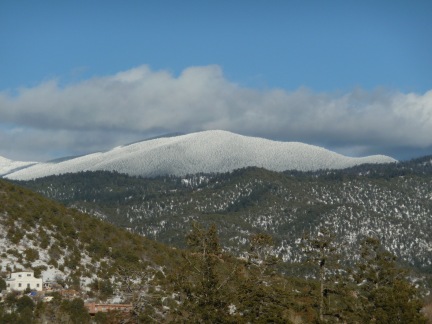
December 8, 2009
As I was shoveling a path to my office early last week, the snow (about 4 1/2 inches) seemed particularly dense. Typing WeatherData[“KSAF”, “TotalPrecipitation”, {{2009, 12, 1}, {2009, 12, 31}, “Day”}] onto a Mathematica page showed that, melted down, Santa Fe received 0.19 inches of precipitation. But that was down at the airport. Amy C. Lewis, a hydrologist who maintains the weather station in Seton Village, just south of town, says she measured 0.42 inches of water from the storm. She has also sent me data filling in the blanks of the Seton chart I compiled earlier this month and has provided measurements from the Santa Fe 2 station dating all the way back to November 1867! She gathered the numbers the old-fashioned way, by poring over the hard copy reports in the State Library. I didn’t even know those records existed.
Another reader, William Henry Mee, has sent me a spreadsheet of his own measurements on County Road 44-A in the San Marcos area. I have included all this new information in what I now will call the Ultimate Santa Fe Precipitation Chart. (You can also download it as a spreadsheet.)
This morning I used the new data to compute 10-year averages dating back a century:
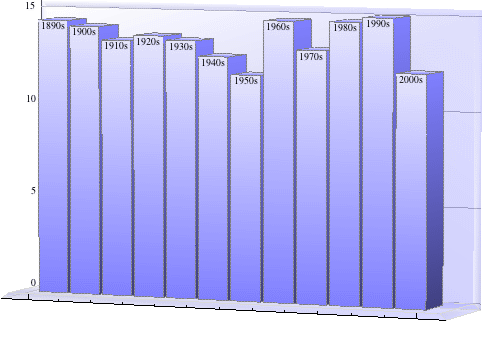
Santa Fe precipitation by decade
On the chart, “1890s” means 1889 to 1898, “1900s” means 1899 to 1908, and so forth. That way the righthand bar represents the most recent full decade of precipitation. You can see how over the last 40 years Santa Fe became accustomed to wetter weather. The population of the county grew like moss, from 38,153 in 1950 to 143,937 by 2008:
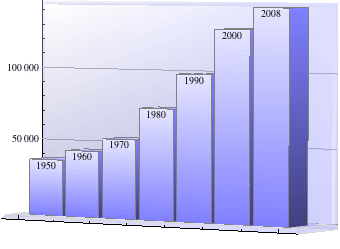
Santa Fe County population by decade
But unlike moss it kept on growing, even as the weather dried up.

Christmas Eve

Ferry terminal, Charlotte Amalie, U.S. Virgin Islands